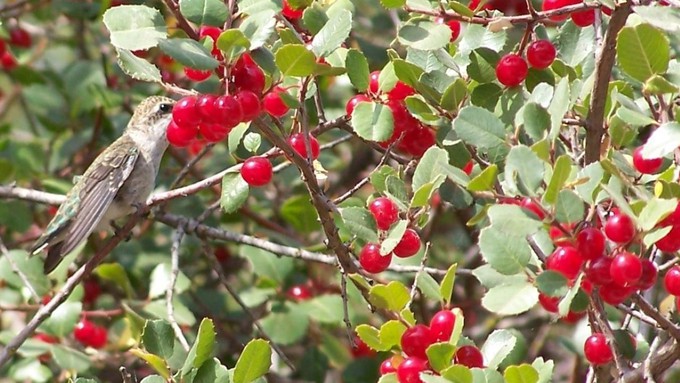
These drought-tolerant shrubs and trees provide food for bees, butterflies and birds

A hummingbird enjoys a hollyleaf redberry (Rhamnus ilicifolia), a native shrub. Courtesy Sac Valley CNPS
Chris Lewis and Robin Rietz know the power of native plants: They’re irresistible – especially to native wildlife.
After all, native plants and native wildlife were made for each other. Native birds, bees and butterflies like to eat the plants where they have always lived; that’s what nature intended.
Near the American River Parkway, Lewis and Rietz grow scores of varieties of wildlife-friendly native plants at the Sac Valley CNPS Nursery and Gardens. Located on Soil Born Farms’ American River Ranch in Rancho Cordova, the nursery – also known as Elderberry Farms – propagates a wide range of local favorites. Its demonstration gardens show off those native plants year round.
At 9 a.m. Oct. 8, Soil Born will host a workshop devoted to California natives. Registration ($30) is now open for “Gardening with Natives Plants,” a hands-on introduction to planning, planting and growing natives. (Go to www.soilborn.org.) Led by Mark Shaffer of CNPS, the class includes a tour of the nursery and demonstration gardens.
Fall is the best time to transplant most native plants, especially shrubs, trees and perennials. It allows them months (hopefully with rain) to put down roots and get established before the stress of summer heat next year.
Native plants tend to be naturally drought-tolerant; they were meant to grow in our often-dry climate. But they also provide food and shelter for native species.
That’s important, notes Lewis. Available habitat and food sources are crucial to native species’ survival.
According to the Audubon Society, the continental United States has lost more than 150 million acres of native plant habitat to urbanization over the past 100 years. That’s devastated the native wildlife that depended on it.
Growing native plants in urban or suburban gardens can help make up for that habitat loss. Otherwise, more species of birds and butterflies will disappear.
“The native plant habitat we protect or add to our landscapes today will determinewhat life looks like tomorrow,” Lewis says. “We’re all part of the web of life.”
Wildlife, especially birds, needs food sources every season. Otherwise, they leave – or starve. In the CNPS demonstration gardens are examples of native plants that offer something for birds and beneficial insects spring through winter.
This year, the nursery’s team created a new “lawn replacement” demonstration garden that would be acceptable to even picky home owners associations. Says Lewis, “We call it our HOA-friendly garden.”
Rietz, the nursery’s propagation director, planted a mix of perennials, shrubs and small trees that mimic traditional landscaping forms but with a lot more life and color. Birds dart among mountain mahogany and hollyleaf redberry while bees buzz the asters and penstemon. Hummingbirds zip between California fuchsia and scarlet monkeyflower.
“The Sonoma sage is beautiful this summer,” Rietz notes. “It hugs the ground and has nice blue flowers.”
Shrubs and trees give structure to any landscape. They also can provide habitat as well as food for wildlife. At the CNPS nursery, dozens of examples are on display.
Berry-bearing bushes add interest to the landscape, too. In late summer and fall, coffeeberry is loaded with marble-size black berries. Conversely, snowberry lives up to its name with pearl-like berries.
“We try to give ideas of how shrubs can be used in the home landscape,” Rietz says. “For example, the mountain mahogany can be hedged.”
Elderberry can be pruned as a small tree or large shrub, Rietz notes. So can toyon.
“These are mega-pollinator plants,” Lewis adds. “There are lots of winter berries for birds, but when they’re in bloom, bees are all over them. I love shrubs that are multi-functional.”
Sac Valley CNPS Nursery and Gardens are located at Soil Born Farms’ American River Ranch, 2140 Chase Drive, Rancho Cordova.
For more details: www.sacvalleycnps.org.
Comments
0 comments have been posted.Sacramento Digs Gardening to your inbox.
Sites We Like
Garden Checklist for week of July 21
Your garden needs you!
* Keep your vegetable garden watered, mulched and weeded. Water before 8 a.m. to reduce the chance of fungal infection and to conserve moisture.
* Feed vegetable plants bone meal, rock phosphate or other fertilizers high in phosphate to stimulate more blooms and fruiting. (But wait until daily high temperatures drop out of the 100s.)
* Don’t let tomatoes wilt or dry out completely. Give tomatoes a deep watering two to three times a week.
* Harvest vegetables promptly to encourage plants to produce more. Squash especially tends to grow rapidly in hot weather. Keep an eye on zucchini.
* Pinch back chrysanthemums for bushy plants and more flowers in September.
* Remove spent flowers from roses, daylilies and other bloomers as they finish flowering.
* Pinch off blooms from basil so the plant will grow more leaves.
* Cut back lavender after flowering to promote a second bloom.
* It's not too late to add a splash of color. Plant petunias, snapdragons, zinnias and marigolds.
* From seed, plant corn, pumpkins, radishes, winter squash and sunflowers.